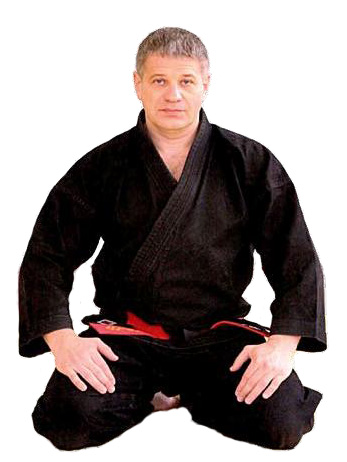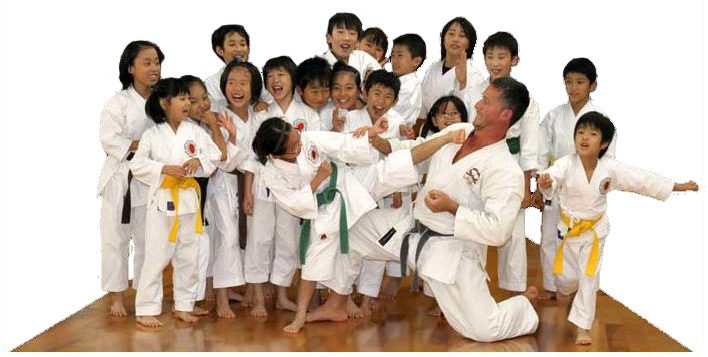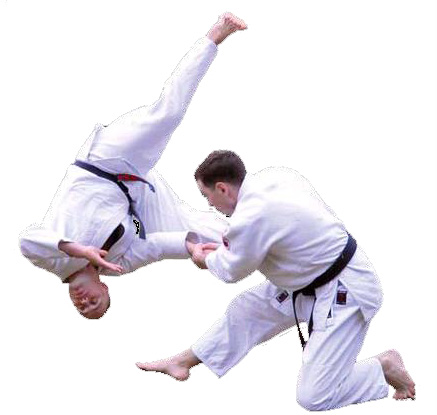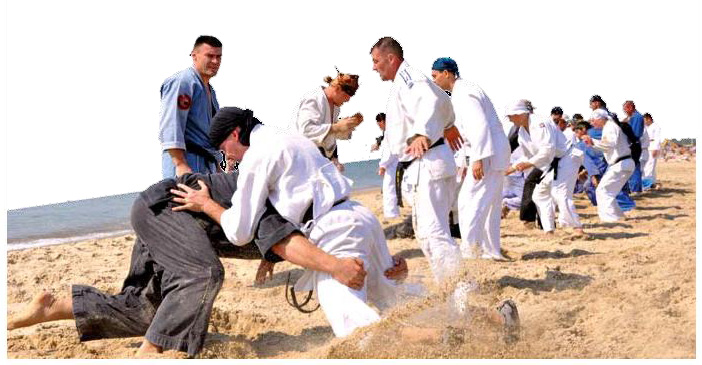Black belt, white lotus…
- Информация о материале
- Опубликовано: 19.08.2015, 23:00
 |
Belarusian BUDO Association instructors have taken prizes at prestigious international competitions many times. Since 2005, they’ve regularly undertake n internships in Japan, preserving the traditions and Japanese roots of unique Jiu-Jitsu for themselves and for their pupils. Sergey Koblov, residing in Minsk, tells us more |
Martial arts mastery has long been thought of ‘cool’ — perhaps more so than being an expert carpenter, jewellery maker, or even athlete or musician. Who among us can deny their admiration for those who can defend themselves with their bare hands? The escapades of fearless warriors on the big screen is even more breath-taking. Many of us must secretly wish to emulate them — especially young boys dreaming of excitement; it’s easy to be allured by hand-to-hand combat.
The martial arts of the East are popular worldwide, although few achieve true perfection. Sergey Koblov is an experienced master, currently residing in Belarus: a chief instructor of the BUDO Association (‘Budo’ means ‘warrior’s road’ in Japanese). The organisation will soon be celebrating its 15th anniversary of uniting Belarusian Jiu-Jitsu instructors of international certification. Mr. Koblov’s pupils have won prizes at international full-contact fighting championships many times and 26 boast black belts (from the first to the fifth dan).
Mr. Koblov gained his fifth dan in 2010, and became an ‘instructor of international class’ and an honorary Renshi (skilled expert). In the autumn of 2005, he won a silver medal at the World Championship for Traditional Jiu-Jitsu, in Japan. He has joined famous Japanese master Yasumoto Akiyoshi as his assistant at international martial arts congresses in Japan (2006), Sri Lanka (2007), Cyprus (2010) and Majorca (2011). Moreover, he has taught at martial arts schools in the UK, Germany, Israel, Spain, Mexico, Russia, Ukraine, Sweden and elsewhere.
According to tradition, February 23rd is not only the Day of Defenders of the Fatherland in Belarus but the unofficial Men’s Day. It’s a good reason to learn more about a man who considers himself to have the spirit of a warrior, filled with true manliness. Today, Sergey Koblov is a guest at our editorial office. What path led him to such a peak of mastery and where does he see it leading him next? How is Jiu-Jitsu developing in Belarus? Why is the experience and mastery of Japanese masters so widely respected worldwide? We explore these questions and more.
Mr. Koblov, tell us, please, what is Jiu-Jitsu?
It’s one of numerous names for the hand-to-hand fighting of the Japanese samurai. Japan once boasted lots of schools, each with its own master and style of teaching. Pupils grasped the secrets of experienced warriors and could later set up their own schools, using their experience. Some took over from their own masters. What remains is a clear respect towards teachers and the succession of knowledge from teacher to pupil. Usually, ‘Jiu-Jitsu’ is translated as a ‘soft art’; however, my Ukrainian colleague Shihan (the head of the school) Yevgeny Radishevsky believes that it can be translated as ‘skill’, ‘technique’, ‘way’,‘mean’ and, even, ‘magic’. He confirmsthat the fundamental principle of Jiu-Jitsu is in its title, while differing fromother martial arts.
Martial arts are thought to keep the body fit but this can’t be the main reason for people taking up this form of handto-hand fighting.
Those actively engaged in Jiu-Jitsu do keep fit, since this is needed to ensure the development of their mastery: Jiu-Jitsu was created in a military environment with the aim of preparing soldiers. It also has a romantic, even exotic, image but these aspects are superfluous really.
We teach ourselves how to beat an opponent and remain alive. Judo, which is already an Olympic sport, also originates from Jiu-Jitsu. Of course, all sports engender a desire to win. Jiu-Jitsu schools have strict discipline, as well as an obligatory programme to follow — just as in gymnastics and ballet. There are dozens of elements and movements to master before you become a true expert. Artists, composers and musicians must have the same discipline to achieve success. Sometimes, pupils ask me why all this is necessary, so I explain that, before fighting, you need to gain full control over your ‘weaponry’, learning to master it virtuously. Sometimes, these are parallel processes. Each school has its own approach and even untraditional Jiu-Jitsu schools, especially those beyond the borders of Japan, give good training to pupils.

What path brought you to Japanes emartial artsand Jiu-Jitsu?
Back in the 1970s, when Judo first began appearing in the USSR, rumours spread of an unusual combat art: Jiu-Jitsu (the correct pronunciation is ‘Ju-Jutsu’ while ‘Jiu-Jitsu’ is the European variant). I was interested, having previously practised karate and boxing. After leaving the army, an acquaintance took me to a martial arts class. I read books independently — often making copies of significant pages. We lacked a qualified teacher, being headed by a former karate expert, but I had a true wish to train. That school continues to exist in Minsk even now; I taught there myself for a while.
I believed that we were practising Jiu-Jitsu there until I visited an international congress in Budapest in 1991. There, I saw a dozen European masters of a high level — all of whom had achieved 6th to 8th dan: French, Greeks, British and Germans… It turned out that we were not practising Jiu-Jitsu at all. After the trip, we viewed ourselves in a different light and wanted to make changes. However, the heads of the school had their own vision and disagreed with ours. As in any business, you need to inject something to receive something back — for example, when studying with European or Japanese masters. It’s no secret that sport is a commercial business, attracting pupils and money. Money wasn’t investedin our case; the school still operates but, in my opinion, has nothing to do with Jiu-Jitsu.
I think you set yourself highstandards.
I wouldn’t say that I’m a revolutionary in my field but I do give my all and prefer Jiu-Jitsu over anything else. To explain, the lotus represents personal harmony in Eastern philosophy — its five petals symbolising the five areas of knowledge to be mastered by any pupil: medicine, martial arts, body training, morality and spiritual enlightenment. If any single petal is too small or large, the harmony of the flower is disturbed; everything should be in balance.
Of course, I wanted to develop harmoniously, while the school I spokeof was primarily focused on recuperation, while only offering a basic level of technical training. I’m not saying thatthis is bad — only that it’s not Jiu-Jitsu. Anyway, I’m grateful to the founders of the school, as they created a ‘crossing’ in my life, from which I’ve come to discover my present day self. I tell you this in detail, so that you know similar schools exist worldwide without Japanese traditions, succession of knowledge or the experience of true masters. Don’t be allured solely by ‘beautiful packaging’. I went in search of my own ‘bliss’. Many opportunities exist to learn, although not everyone appreciates this. Even Sōke (the head of the school) Yasumoto Akiyoshi — one of the most authoritative masters of traditional Jiu-Jitsu of our time (boasting the tenth dan) — has visited Minsk at my invitation and conducted lessons. He is famous in Japan as an expert in the history of samurai families. We’re also both keen on underwater archaeology, which I’ve been practising for twenty years.

How did your
colleagues in Minsk
view the
arrival of such
a Japanese Jiu-
Jitsu patriarch?
Of course, many
were delighted; others
were surprised that so
many Jiu-Jitsu schools exist
worldwide, each being so different
from each other. One of my school
head colleagues was greatly surprised
to learn that I’d been already certified in
four belts — by four schools. I’ve since
been certified in five belts. There’s also a
European variant of Jiu-Jitsu, which has
almost lost its Japanese roots, becoming
an independent variety of hand-tohand
fighting. Unfortunately, we can’t
find mutual understanding even with
the heads of Belarusian schools; it’s
sometimes more difficult to overcome
one’s own ambitions than to beat an
opponent in a fight.
Mr. Koblov, you’ve told us about
various Jiu-Jitsu schools. Which areas
are you developing?
The basic areas being developed by
instructors of the BUDO Association are
Bushinkan Jujutsu, Jukoshin Ryu Jujutsu,
and Jukite Happo Bugei. One of the
achievements of recent years has been our
senior instructor Pavel Dyatko winning
an international championship in Japan
in 2010: in Motoha Yoshin Ryu Jujutsu
(kata version). You can view the details
on the Association’s website. Currently,
over 400 pupils train with us (aged 5 to
50+) in Minsk, Brest, Pinsk, Vitebsk,
Novopolotsk and Mogilev. We also have
a branch in Lithuanian Vilnius.
Importantly, since 2005, our instructors
have been regularly passing internships
in Japan, so
they can follow Japanese
traditions and understand
their roots. Moreover, Belarus’
BUDO Association represents
such famous organisations as
the Motoha Yoshin Ryu
International
(head
quar
tered
in
Japanese Yonago), the
WEBBS (the World
Elite Black Belt Society, headquartered in
London) and the Bushinkai International
(headquartered in Ukrainian Odessa).
Some of our instructors have trained
at the Belarusian State University of
Physical Culture [now, the Academy of
Physical Culture and Sports] in ‘judo
coaching’. We attend seminars abroad,
while organising visits by famous
specialists of martial arts to Belarus, so
our instructors and pupils can display
their talents and learn from others.
Do you harmoniously ‘fit’ the world
network of Jiu-Jitsu schools?
I have friends all over the globe and
have managed to visit 45 countries,
although not only connected with Jiu-
Jitsu affairs. Quite a few Japanese masters
of Jiu-Jitsu live across the world — each
true patriarchs of their style. It’s important
to bear this mind, to correctly understand
the paths of Jiu-Jitsu worldwide. The art
arrived in Western Europe in the 1960s —
and in Belarus in the 1980s. A number of
European masters, who are over 60 now,
were personal pupils of Japanese masters.
Today, they tend to run their own international
organisations, uniting clubs from
20-30 various states.
How would you characterise the
essence of your mastery?
Technique is the essence of Jiu-Jitsu.
The traditional system of Jiu-Jitsu doesn’t
require huge physical strength but it’s vital
to know how to balance, as well as your
directions of attack and the body’s tender
points. Knowing this, you can dominate
your opponent, regardless of your age.
Belarusians say that ‘a son wins by his
strength while a father has his own way’
— meaning that less exertion is needed
when you’ve mastered a technique…
Yes, masters are respected in all
nations. As the years pass, we don’t
become younger, so we must conserve
our energy. However, there are a range of
practices which we can use to expand the
opportunities of our body — as used
in traditional Jiu-Jitsu schools. For
example, gymnastics can activate
our reserves.
Knowledge used to flow from
one country to another in South-East
Asia, in various ways. Practices may
have differed but the final result was
similar. Goals also coincide in religions:
spiritual Orthodox practices, like those
of Buddhists, Hindus and shamans, aim
towards enlightenment. We too have
practices. It’s vital to select that which
will help you to find yourself fully. It’s
sometimes difficult and ‘strong-arm’
methods are useless. You need to be
ready and mature; then, a teacher will
always be forthcoming. If you aren’t
ready, no teacher can help you.
Does this mean that you were ready
to ‘absorb’ the mastery of Jiu-Jitsu when
you acquired a true Japanese teacher?
Yes. I’m pleased that all my pupils have
remained with me. In the mid-1990s, we
began to visit Hungary and established
contacts with the Jiu-Jitsu Federation,
which invited many different masters.
During my first meeting, I was lucky to
attend the jubilee of the IMAF — the
International Martial Arts Federation,
headquartered in Tokyo. At that time,
I saw ten Japanese masters of various
trends. I’m proud to have attended the
Kanazawa seminar (a leading karate
master). I sat with him at one table and
was welcomed heartily — although
Belarus was a complete newcomer to the
world of Jiu-Jitsu at that time.
Who are these ‘Celestial Fathers’ of
martial arts?
They’re ordinary people. I must admit
this was a time when many of my stereotypes
were collapsing. It turned out that
you may drink alcohol, in moderation.
Some smoke and enjoy joking and dancing.
Myths exist regarding complete asceticism
and wearisome training. Rather, they
are wonderful people boasting virtuoso
fighting techniques and original world
outlooks. We can learn much from them.
I enjoyed my visit and often returned to
Hungary, where I gained black belt certification
by the Japanese. There was a time
when it seemed to me that I already knew
everything and the whole world lay before
me… until Yevgeny Radishevsky appeared.
He was born in Ukrainian Odessa,
visiting workshops and communicating
with various masters; he would
stay for a week to learn from them. He
also boasts a special gift: being able to
share his knowledge. I believe that he is
the best in Jiu-Jitsu within the CIS and
has a great future. Yevgeny asked me to
join his Bushinkan organisation. At that
time, we’d already established our BUDO
Association, which is celebrating its 15th
anniversary this year. ‘Budo’ refers to all
Japanese martial arts, with its two
characters meaning ‘warrior’s
road’. ‘BU’ consists of two
parts: a stop and a spear
(the stopping of a spear). It
advocates protection rather
than aggression, which
I believe is an essential
aspect of the whole BUDO
system.
Do true masters teach the ‘road of a
warrior’ in such a way as to counteract
natural aggression?
Yes, although not everyone can
understand this. For example, some
Europeans say that we’d like to fight if
given the opportunity. A master from
the East would rather say that we can
fight but choose not to. In this respect,
I’m totally on the Eastern side, although
I’m a European. BUDO is primarily a
way of understanding yourself, eradicating
your weaknesses. When you
realise that you can quickly injure
someone, you become disgusted with
the idea of fighting. I learnt this from a
few difficult situations. The best fight is
one which never takes place. When I see
that someone is looking for trouble, I try
to prevent it — even to the injury of my
own ambitions.
You’ve used your mastery outside
fighting halls, haven’t you?
They were unpleasant moments.
In the morning, I’d look at my sleeping
son and be determined to be tolerant,
so as to avoid prison. When aggression
overtakes you, it takes much willpower
to control it. I fought habitual offenders,
who don’t obey any rules when fighting.
Once, I shifted a crowd’s aggression from
an elderly person onto myself. I wasn’t
myself for three days afterwards, because
I had to fight so determinedly.
My
acquaint
ance,
whom I protected, told me not to
reproach myself, as they would have
beaten him if not me. Then, I began to
view the situation differently. There’s a
saying that a Russian person cannot be
refused a fight — so, if you won’t fight
them, they’ll find another to fight with.
I realised that it’s better for them to fight
me, since I’m prepared, which might
remove the fighter’s desire in the future.
Mr. Koblov, are you more of a teacher
or a warrior?
I think I’m now a teacher of
warriors (smiles). I graduated from the
Minsk Pedagogical Institute in ‘history
and French language’ and spent 15
years as a teacher of physical culture
and swimming in schools. I’ve had 12
professions! I’ve inherited my love of
hard work from my parents: the words
Taishet, Abakan and Komsomol are
like lines in their biographies. I was
born in Russian Angarsk, near Irkutsk,
but have resided in Belarus since
childhood. I can easily find a common
language with like-minded people from
around the world and speak a little
Spanish, French and English — plus a
tiny bit of Japanese. However, Japanese
terminology relating to martial arts is
capacious; if I’m told a technique in
Japanese I understand what it means.
Of course, nuances and aspects can be
explained in English, so I try to make
time to study it — not an easy task.

By Ivan and Valentina
Zhdanovich
Перепечатано из журнала "BELARUS" No.2 (941), 2012





 Клуб восточных единоборств "Сэнкё"
Клуб восточных единоборств "Сэнкё"